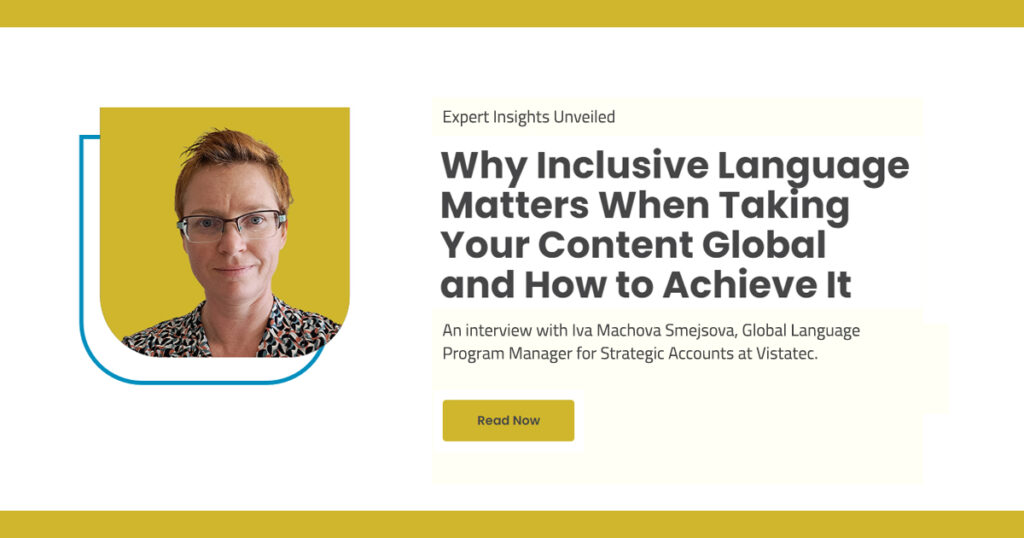
and How to Achieve It

Subscribe to this content series and be the first to be notified when new content is released
Subscribe to this content series and be the first to be notified when new content is released
Why Inclusive Language Matters When You Take Your Content Global and How to Achieve It
An interview with Vistatec’s Iva Machova Smejsova, Global Language Program Manager for Strategic Accounts
In a marketplace where consumer values are shifting rapidly, and diversity is more than just a buzzword, businesses cannot ignore the importance of inclusive language in their multilingual content and communications.
For example, according to HubSpot, 50% of Gen Z and 49% of Millennials choose products based on the brand’s commitment to diversity and inclusion.
In response to this shift, businesses increasingly focus on diversity, equity, and inclusion (DEI) initiatives to appeal to modern buyers, reduce stereotypes, celebrate diversity, and convey respect for everyone. These initiatives include the careful use of language. In today’s global market, inclusive language is not just good ethics; it’s good business.
And when businesses go global, they must also make sure their commitment to inclusivity is reflected in their international content.
As linguistic and cultural experts, language services providers are defining global approaches to inclusive language to produce content that resonates with diverse audiences.
To learn more about how LSPs are rising to the occasion, we spoke with Iva Machova Smejsova, Global Language Program Manager for Strategic Accounts at Vistatec and an expert on language quality frameworks. With 17 years in the localization industry, Iva has extensive experience understanding quality in translation and driving processes to manage it. She is passionate about the use of analytics in driving linguistic quality. Since inclusive language is part of quality for organizations prioritizing it, Iva has invaluable insights to share on inclusive language globally.
Can you give us your perspective on what inclusive language is and what it is not?
Iva: A common misconception is that inclusive language is solely about gender neutrality. While gender is a part of it, inclusive language is more broad than that. It includes sexual orientation, race, religion, age, disability status, and much more. The language we use should welcome people, not act as a barrier.
And that’s positioning that companies need to internalize before they can successfully externalize it.
Before a company can effectively incorporate inclusive language into its translated content, there must be a foundational shift within its culture. Inclusivity must be part of the internal compass that guides your entire organization—not just the details the public sees.
If your internal team clearly understands what inclusivity means, that clarity will naturally extend to your localization efforts. It sets the proper foundation for whatever you produce.
By adopting an inclusive approach from the inside out, companies stand to make ethical strides and deeply connect with a broader, more diverse audience.
However, companies need an expert advisor specializing in inclusive language to help develop guidelines for localized content.
Inclusive language is a hot topic in the U.S. and Europe. Is the rest of the world as interested as we are? What’s the global view on this?
Iva: In my experience, the importance of inclusive language can differ depending on the market’s openness. For example, Sweden was one of the first countries to start discussing this topic seriously.
In France, the French Senate has recently voted in favor of a proposed law banning gender-inclusive language from official communications. However, there has been visible progress in the feminization of job titles under the rules set out in a guide to help feminize the names of professions, titles, ranks, and functions developed by the National Center for Scientific Research and the National Institute of the French language.
Other countries like Germany, Belgium, Spain, and the Baltics are showing significant progress in addressing inclusivity.
Also, an insightful report from Word Economic Forum regarding gender addresses inclusivity, with some points about language usage.
But it’s not just about social change. While some markets, for example, in Asia, may seem less responsive, sometimes language structures can be the stumbling block rather than market readiness.
Some languages are more adaptable to inclusive terminologies, like adding specific pronoun endings. Others, not so much. For example, in Romance languages, all nouns have gender. Similarly, verbs, nouns, and adjectives are all gendered in Arabic. These are not language groups that lend themselves to gender neutrality. So, it’s not just a matter of willingness; sometimes, the language structure can limit progress.
Even in these markets, however, we’re seeing more gender-neutral and inclusive terms evolving and gaining acceptance. For example, young Argentinians are adopting “-e” as a gender-neutral ending for nouns.
It’s a complex issue with many layers, but the push for inclusivity is broader than one or two countries. It’s a global shift driven by various factors, including companies’ aspirations to go international.
There’s a perception that caring about inclusive language is most important to younger generations. What are your thoughts on that?
Iva: The younger generations, like Millennials and Gen Z, prioritize it, especially regarding products and services geared toward them. They’re not just focusing on the price tag anymore when they shop. They’re asking, “Is this company inclusive? Are they sustainable? How do they treat their workforce?” Then they buy, based on that.
So, inclusive language is also a way for companies to stand out in a competitive market.
It isn’t just a buzzword; it’s a serious differentiator. For Millennials and Gen Z, it holds more weight than even the fanciest features a product could offer.
LSPs are focusing on ways to translate inclusively for global markets, which involves translation tools. What translation tools play the most prominent role, and how can we leverage them?
Translation memories help, but be cautious.
Iva: Let’s start with translation memories (TMs). If you’ve been localizing content for some time, it’s likely that your TMs are loaded with legacy terminology that may not be inclusive. Until your terms are updated, this outdated language can creep into your newly translated content. When you decide to shift towards a more inclusive language policy, you face the massive task of cleaning up these TMs.
You’re dealing with years, sometimes decades, of content that needs to be updated to align with modern, inclusive language norms.
Glossaries and style guides can light the path forward.
Iva: Glossaries can be invaluable. They act as a ‘cheat sheet’ that teams can refer to to ensure they meet the expectations for inclusive language. Automatic glossary tools also find problematic terms and insert the preferred term. Different nonprofits and advocacy groups have existing references you can use.
Then, a style guide is your rulebook for each target language. As mentioned, not all languages are created equal when adopting inclusive terms. Some languages lend themselves easily to inclusive language, while others offer unique challenges that don’t have straightforward solutions. You have to find a workaround for those.
That’s why the style guide is such a critical tool. It’s tailored to the features of each language and provides a roadmap on how to navigate these issues.
But these are living documents.
Language, and our understanding of what constitutes inclusive language, is fluid and ever-changing. What may have been acceptable a year ago might not be today. These resources need to evolve along with the trends.
Can you give an example of language differences that make inclusive translation difficult?
Iva: Let’s take Slavic languages as an example. In English, we can swap out pronouns easily without changing the rest of the sentence. But in Slavic languages, it’s not just the pronoun that is gendered; the noun and the verb in a sentence can also change based on gender. So, when you’re talking about a man doing something versus a woman doing the same thing, the rest of the sentence changes quite a bit. It’s not just about “he” or “she”; it’s more complex than that.
In this case, we give the linguist the freedom to rewrite sentences in a way that maintains the inclusive intent, even if it diverges from the source text. With some creativity, there are often ways to rephrase a sentence so that gender becomes a non-issue.
Also, some languages create ‘neopronouns’ to provide a neutral option. These are gender-neutral or nonbinary pronouns like “xe” and “em.” Interestingly, some of them even date back several centuries, when writers introduced them as a solution for referring to subjects without assuming gender. However, they aren’t recognized officially yet.
Using Quality Automations
There are also automated software solutions designed to check your final content for non-inclusive or negative terms. It’s straightforward; you program the software to flag a predefined list of unacceptable words. These words are then highlighted or blocked so they can be changed before the final product is released.
Understanding how ready your organization is to tackle these initiatives can be helpful. How do you assess this?
Iva: I generally categorize clients into three stages of their inclusivity journey: just getting started, mid-level, and mature.
The first stage is for those who are just starting. These businesses are putting together the guidelines, the style guide, and the glossary and beginning to analyze existing content. One mistake we see organizations make at this level is that they sometimes want to work incrementally, one project at a time, when it would be better over the long term to take the time and lay down those guardrails.
Those at the mid-level of maturity focus on filling gaps. They are building on what’s already working.
Those who have a mature, inclusive language program have already laid a lot of the groundwork. They focus on execution and optimization, making the most of their established resources.
By assessing the client’s current maturity level, we can suggest clear next steps to move forward efficiently.
The initial investment in inclusive language efforts can be significant. What does the return on that investment look like?
Iva: The upfront costs can be substantial, but the ROI extends beyond immediate financial returns. We’ve found that it pays off generously in the long run.
One of the immediate benefits we’ve observed is a positive shift in brand perception, especially among younger audiences who prioritize inclusivity. Sales increase in that demographic. They not only appreciate these efforts but often become brand advocates. A strong fanbase also increases sales.
Also, inclusive language can serve as a differentiation strategy. It sets a brand apart from competitors who are not inclusive, and so it is mandatory for brands whose target market care about this differentiator. It affects how your brand is perceived, who engages with it, and how loyal your customer base becomes.
Bringing your brand into the future with inclusive localization
The stakes are high for building inclusive translation programs that appeal to target demographics who value inclusivity. A misstep could damage a brand or alienate those high-value buyers. On the other hand, thoughtful inclusion and localization can build trust and loyalty.
To get started, brands need to:
- Evangelize internally about the importance of inclusive language.
- Define their approach (using a specialist in inclusive language).
- Assess how they can use linguistic assets like glossaries, style guides, and translation memories.
- Look into quality automations.
- Be aware of regional variations in approach, depending on market readiness and language constraints.
- Establish style guides and processes to drive inclusive language in translated content.
There’s no one-size-fits-all approach to navigating this landscape. Each company has its own unique goals and challenges. That’s why we combine a consultative approach with state-of-the-art tools to tailor a solution that’s just right for your business.
Our experts are here to help you develop an inclusive localization strategy that addresses each language’s unique challenges. Contact us to get started!

Sign up to this content series and be the first to be notified when new content is released
Sign up to this content series and be the first to be notified when new content is released

